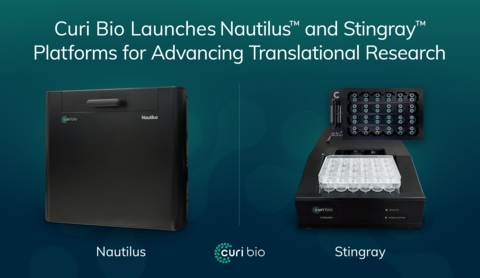SEATTLE– Curi Bio, a leading developer of human stem cell-based platforms for drug discovery, today announced the commercial launch of its Nautilus™ and Stingray™ platforms for advancing preclinical drug discovery. With Nautilus, researchers can now interrogate the electrophysiology of their 2D or 3D cell cultures using the latest optical measurement techniques at the push of a button. The Stingray platform allows for maturation of 3D tissues via electrical stimulation with a level of versatility currently unmatched in the industry. As an integrated part of Curi Bio’s growing ecosystem of preclinical human modeling platforms, these innovative technologies promise to transform the way researchers can assess physiologically relevant data such as safety and efficacy earlier in the drug discovery process.
The Nautilus and Stingray platforms are both available as standalone bioscience instruments. Additionally, Stingray can be deployed as a complement to Nautilus as well as Curi Bio’s existing market-leading biosystem platforms such as Mantarray (3D engineered muscle tissue platform for contractility analysis), Pulse (high-throughput video analysis of contractility), and MantaReady iPSC-Derived Skeletal Muscle Myoblasts and 3D Skeletal Muscle Tissue Medium.
Next-generation cell models hold great promise for assessing both the safety and efficacy of drugs before they are sent to expensive and risky clinical trials. However, the bioengineering strategies required to make these models at the scale that pharmaceutical researchers need and acquire meaningful data from them has been out of reach for most scientists. Curi Bio’s mission of democratizing these once inaccessible approaches continues with the commercial launch of Nautilus and Stingray. Optical measurements of a cell’s calcium and voltage transients are often laborious, low throughput, and incompatible with complex 3D tissues. Nautilus solves these problems while addressing the pressing demand from researchers to get translational data faster using turnkey solutions.
With Nautilus, researchers are empowered with deep insight into the electrophysiology of their cells with a platform that condenses days of data acquisition and analysis into mere minutes with an automated, push-button workflow. Nautilus removes the requirement for manual programming and calculations while enabling user-friendly quantification of action potential duration, calcium transients, triangulation, and other key electrophysiological metrics. Nautilus frees users to focus on their science rather than struggle with their bioengineering tools. Nautilus works with virtually any SBS-compliant plate format to provide information-rich output on samples ranging from 2D monolayers to complex 3D organoids. This compatibility with both 2D and 3D electrophysiological samples provides users with unparalleled experimental flexibility for a wide range of applications in drug discovery and screening.
The Stingray instrument is the newest addition to the Mantarray product family. Stingray empowers researchers with full experimental control of their 3D cell culture experiments, featuring up to 24 unique electrical stimulation protocols that can be applied to 3D tissues in culture. Stingray features an intuitive and easy-to-use software with the capability to schedule long-term stimulation experiments for chronic pacing studies. The Stingray system can be used on its own or as an accompaniment to Mantarray or Nautilus when experiments require long term pacing. Stingray users will also have the ability to upgrade their system to a Mantarray to access functional measurements of force.
“At Curi Bio, our goal is to provide researchers with innovative, turnkey solutions to accelerate the discovery of new medicines,” said Dr. Nicholas Geisse, CEO of Curi Bio. “We are excited to introduce the Nautilus and Stingray platforms, which represents a significant leap forward in the field of 3D tissue development and assessment. With these and other Curi platforms, any researcher can get deep insights into complex disease biology, without having to learn sophisticated bioengineering or data analysis techniques. This is another step towards realizing our mission to empower scientists with innovative human-relevant tools that accelerate drug discovery and improve patient safety.”


